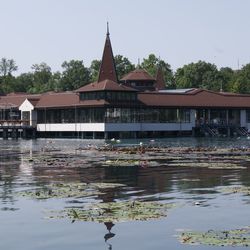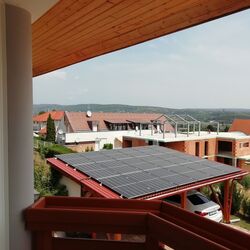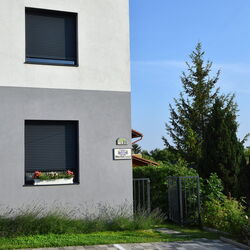Handmade, all-natural, fruit-packed
In a small workshop on Egregyi Wine Hill, gently overlooking Hévíz, Csizmás Syrups are born. Their defining feature? Real fruit, no artificial flavors or sweeteners. László Németh, the founder and creator, wanted to revive the authentic taste of syrups he grew up with — the kind where “raspberry tastes like raspberry.” If you too remember the taste of real, homemade syrup, László’s creations will bring back that countryside nostalgia with every sip.
Everything was in place — It just had to begin
Gastronomy and hospitality have always been close to László’s heart, having worked in these fields abroad before returning home to Hungary. His family grows fruit in Pankasz, a village in the Őrség region, so when there was surplus fruit, László experimented with making his own raspberry, strawberry, and sour cherry syrups.
After much trial and error, the Csizmás Syrup brand was born — and customer feedback quickly confirmed its place in the market. Real fruit, real taste, without compromise.
Ingredients from trusted sources
Since its founding in 2018, Csizmás Syrup has followed one simple principle: only bottle what László himself would happily consume. Most of the ingredients come from family production: raspberries, strawberries, and sour cherries are grown in Pankasz, Vas County. Elderflowers are foraged by László himself each May, far from roads and pollution. Hemp is grown right behind his workshop on the Egregyi Wine Hill.
Traditional craftsmanship, no compromises
Every step of the process is done by hand — from milling the fruit to bottling — ensuring the highest quality. Csizmás Syrups are made cold-pressed, without pasteurization or cooking, preserving the fruits’ authentic flavor, color, and vitamin content. The juices retain fruit pulp and seeds, adding body and richness: raspberry seeds remain in the syrup, strawberry bits stay in the juice.
The fruit content is impressively high — at least 40%. Only minimal preservatives and just enough sugar are used to achieve the desired taste profile. As László says: “Never skimp on the fruit and work as quickly as possible.”
The result is a product that captures nature’s true flavors — no artificial aromas, just lasting, real taste.
Real fruit, lasting flavors
The product range includes raspberry, strawberry, sour cherry, elderflower, and the unique hemp syrup. The hemp version is lightly herbal, calming, and many enjoy it as a relaxing evening drink. László only releases products he’s personally satisfied with — if a recipe doesn’t meet his high standards, it doesn’t make it to market.
Product highlights
Hemp Syrup
Hemp syrup is a true rarity, unique in both taste and effect. Made from industrial hemp (Cannabis sativa) grown without chemicals on Egregyi Wine Hill, László harvests the female hemp flowers in autumn and cold-processes them to preserve their valuable active compounds — known for their calming and stress-relieving properties.
The syrup’s flavor is gently spiced, refreshingly herbal, and balanced with a hint of lemon. It contains only natural ingredients and a minimal amount of sugar. Perfect as a refreshing drink diluted with water or soda, but many also enjoy it before bedtime for its soothing effects.
Serving Tip: For best taste, mix Csizmás Syrup with water or soda in a 1:8 ratio.
Where to buy
- Hévíz Farmers’ Market

Imagine a vast body of water — over 1,000 meters deep and more than 400 times the size of Lake Balaton — once rippling across this land. The story of the Pannonian Lake is not just a fascinating chapter of geological history, but a legacy that continues to shape the region: it left behind mineral resources, fertile soils, and even inspired legends. Discover how an ancient lake transformed Transdanubia — and why its impact is still felt today.
An Inland Sea for Millions of Years
At its greatest extent, the Pannonian Lake covered an enormous area, far surpassing the size of today’s Balaton. For millions of years (approximately 12 to 8.5 million years ago), it dominated the region. As surrounding mountain ranges gradually rose, the lake became cut off from the world’s oceans. Its water slowly turned fresh, and its basin began to fill with sediments. Because of its isolation, the lake developed a unique ecosystem with many endemic species.
The Lake Didn’t Appear Overnight
The Pannonian Lake didn’t simply “appear” in the Carpathian Basin. Its formation was the result of millions of years of tectonic activity and shifting climate. It emerged as an independent, enclosed body of water — no longer connected to the open seas.
Deep Waters, Varied Shores
In some areas, the lake reached depths of over 1,000 meters. Elsewhere, shallower zones supported lagoons, river deltas, and small, isolated lakes. During high water periods, rocky shorelines formed along the mountain fringes — traces of which can still be found today in the Keszthely Hills and the Mecsek Mountains.
The Lake’s Retreat — and Sediment Legacy
Despite its size, the lake was eventually filled in by immense volumes of sediment, carried mainly by rivers flowing from the Alps and the Carpathians. Over the course of 6.5 million years, it gradually disappeared from the landscape.
What did it leave behind?
Its sediments — composed mostly of sand, clay, and fine silt — became the so-called “Pannonian formations,” which today hold key mineral resources (such as petroleum) and aquifers. These formations define much of the surface geology of Transdanubia, including the Zala Hills.
Fertile soils later formed on the laminated silty and clay-rich deposits of the Somló Formation. Even the legendary “Tihany goat’s hoof” fossils — actually worn shell fragments of the Congeria ungulacaprae mollusk — can still be found embedded in these ancient layers.
The Final Lakes and a Gradual Goodbye
Because most of the sediment entered from the northwest, north, and northeast, the lake slowly retreated toward the south and southeast — as if it were “withdrawing” from what is now Hungary.
Small remnant lakes persisted for much longer in areas of present-day Slavonia (Croatia) and northern Serbia, but due to their different scale, character, and fauna, they are not considered true successors of the ancient Pannonian Lake.















